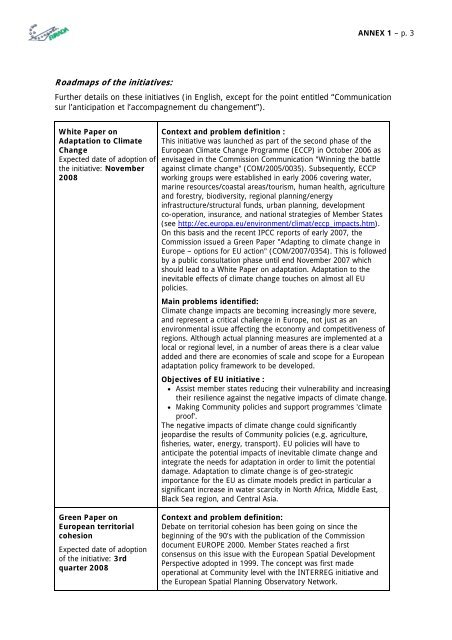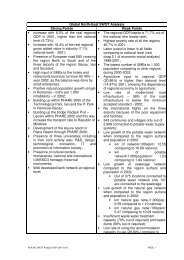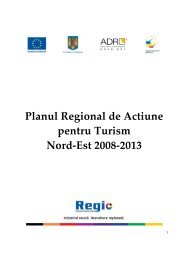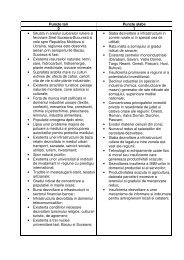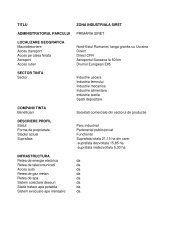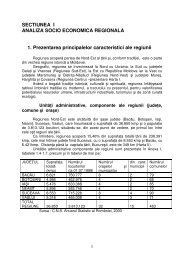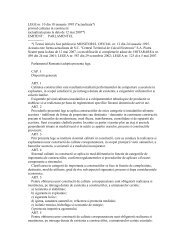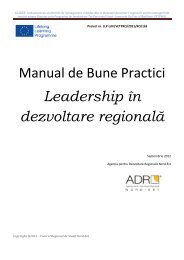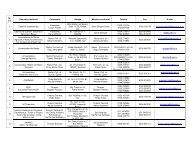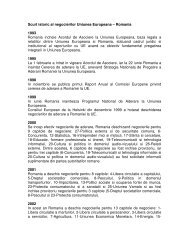EURADA News no. 288
EURADA News no. 288
EURADA News no. 288
Create successful ePaper yourself
Turn your PDF publications into a flip-book with our unique Google optimized e-Paper software.
ANNEX 1 – p. 3<br />
Roadmaps of the initiatives:<br />
Further details on these initiatives (in English, except for the point entitled “Communication<br />
sur l’anticipation et l’accompagnement du changement”).<br />
White Paper on<br />
Adaptation to Climate<br />
Change<br />
Expected date of adoption of<br />
the initiative: November<br />
2008<br />
Context and problem definition :<br />
This initiative was launched as part of the second phase of the<br />
European Climate Change Programme (ECCP) in October 2006 as<br />
envisaged in the Commission Communication "Winning the battle<br />
against climate change" (COM/2005/0035). Subsequently, ECCP<br />
working groups were established in early 2006 covering water,<br />
marine resources/coastal areas/tourism, human health, agriculture<br />
and forestry, biodiversity, regional planning/energy<br />
infrastructure/structural funds, urban planning, development<br />
co-operation, insurance, and national strategies of Member States<br />
(see http://ec.europa.eu/environment/climat/eccp_impacts.htm).<br />
On this basis and the recent IPCC reports of early 2007, the<br />
Commission issued a Green Paper "Adapting to climate change in<br />
Europe – options for EU action" (COM/2007/0354). This is followed<br />
by a public consultation phase until end November 2007 which<br />
should lead to a White Paper on adaptation. Adaptation to the<br />
inevitable effects of climate change touches on almost all EU<br />
policies.<br />
Main problems identified:<br />
Climate change impacts are becoming increasingly more severe,<br />
and represent a critical challenge in Europe, <strong>no</strong>t just as an<br />
environmental issue affecting the eco<strong>no</strong>my and competitiveness of<br />
regions. Although actual planning measures are implemented at a<br />
local or regional level, in a number of areas there is a clear value<br />
added and there are eco<strong>no</strong>mies of scale and scope for a European<br />
adaptation policy framework to be developed.<br />
Objectives of EU initiative :<br />
• Assist member states reducing their vulnerability and increasing<br />
their resilience against the negative impacts of climate change.<br />
• Making Community policies and support programmes 'climate<br />
proof'.<br />
The negative impacts of climate change could significantly<br />
jeopardise the results of Community policies (e.g. agriculture,<br />
fisheries, water, energy, transport). EU policies will have to<br />
anticipate the potential impacts of inevitable climate change and<br />
integrate the needs for adaptation in order to limit the potential<br />
damage. Adaptation to climate change is of geo-strategic<br />
importance for the EU as climate models predict in particular a<br />
significant increase in water scarcity in North Africa, Middle East,<br />
Black Sea region, and Central Asia.<br />
Green Paper on<br />
European territorial<br />
cohesion<br />
Expected date of adoption<br />
of the initiative: 3rd<br />
quarter 2008<br />
Context and problem definition:<br />
Debate on territorial cohesion has been going on since the<br />
beginning of the 90's with the publication of the Commission<br />
document EUROPE 2000. Member States reached a first<br />
consensus on this issue with the European Spatial Development<br />
Perspective adopted in 1999. The concept was first made<br />
operational at Community level with the INTERREG initiative and<br />
the European Spatial Planning Observatory Network.


